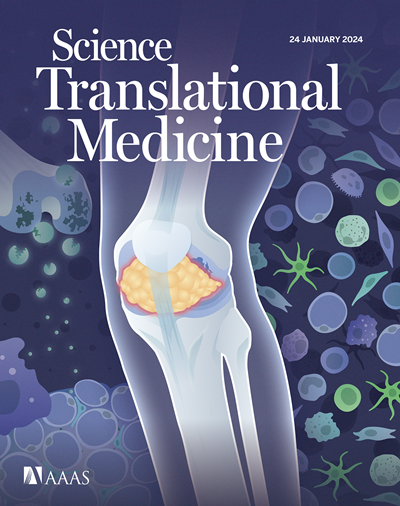在临床前模型中,通过超低剂量x射线诱导光动力疗法和金基纳米团簇靶向抑制胶质瘤
IF 14.6
1区 医学
Q1 CELL BIOLOGY
引用次数: 0
摘要
高级别胶质瘤的弥漫性和浸润性在治疗和管理方面提出了持续的挑战。放疗是胶质瘤的重要治疗手段,标准放疗剂量为60灰度。然而,高剂量放疗会对正常组织产生辐射诱发的副作用。闪烁体介导的使用千伏x射线的低剂量x射线诱导光动力疗法已被证明对多种肿瘤类型有效,而不会对健康组织造成损害。然而,由于光敏剂无法穿过血脑屏障,x射线诱导的光动力疗法尚未在胶质瘤中进行探索。在这里,我们提出了一个集成的金团簇发光原,其中包含与光敏剂和细胞穿透肽偶联的蛋白质保护金纳米团簇。通过活体成像,我们发现金簇发光原在健康动物中穿过完整的血脑屏障,并在两种小鼠颅内原位胶质瘤模型的肿瘤中积累。金簇发光原在与临床超压放疗相同的方案下,有效抑制胶质瘤生长,延长动物在超低剂量x射线治疗(共2次灰色,超压x射线)下的生存。此外,在超低剂量x射线治疗下,金簇发光原能有效抑制原位患者来源的异种胶质瘤模型的肿瘤生长,延长动物存活时间。金簇发光原通过肝脏和肾脏排出,未见毒性。这些结果强调了开发具有较少副作用的临床相关胶质瘤疗法的新机会。本文章由计算机程序翻译,如有差异,请以英文原文为准。
Targeted suppression of glioma by ultralow-dose x-ray–induced photodynamic therapy and gold-based nanoclusters in preclinical models
The diffuse and infiltrative nature of high-grade gliomas poses ongoing challenges in treatment and management. Radiotherapy is an important glioma treatment, with a standard radiotherapy dose of 60 gray. However, high-dose radiotherapy is associated with radiation-induced side effects on normal tissue. Scintillator-mediated low-dose x-ray–induced photodynamic therapy using kilovoltage x-rays has been shown to be effective for multiple tumor types without causing damage to healthy tissue. However, x-ray–induced photodynamic therapy is yet to be explored in glioma because of the inability of the photosensitizers to cross the blood-brain barrier. Here, we present an integrated gold clustoluminogen containing protein-protected gold nanoclusters conjugated to a photosensitizer and a cell-penetrating peptide. Using intravital imaging, we showed that gold clustoluminogen crossed the intact blood-brain barrier in healthy animals and accumulated in tumors in two murine intracranial orthotopic glioma models. Gold clustoluminogen efficiently suppressed glioma growth and prolonged animal survival under ultralow-dose x-ray treatment (total 2 gray, megavoltage x-ray) using the same protocol as that used for clinical megavoltage radiotherapy. Moreover, gold clustoluminogen potently inhibited tumor growth in an orthotopic patient-derived xenograft glioma model with prolonged animal survival under ultralow-dose x-ray treatment. Gold clustoluminogen was eliminated through hepatic and renal excretion, with no observed toxicity. These results highlight new opportunities to develop clinically relevant glioma therapies with reduced side effects.
求助全文
通过发布文献求助,成功后即可免费获取论文全文。
去求助
来源期刊

Science Translational Medicine
CELL BIOLOGY-MEDICINE, RESEARCH & EXPERIMENTAL
CiteScore
26.70
自引率
1.20%
发文量
309
审稿时长
1.7 months
期刊介绍:
Science Translational Medicine is an online journal that focuses on publishing research at the intersection of science, engineering, and medicine. The goal of the journal is to promote human health by providing a platform for researchers from various disciplines to communicate their latest advancements in biomedical, translational, and clinical research.
The journal aims to address the slow translation of scientific knowledge into effective treatments and health measures. It publishes articles that fill the knowledge gaps between preclinical research and medical applications, with a focus on accelerating the translation of knowledge into new ways of preventing, diagnosing, and treating human diseases.
The scope of Science Translational Medicine includes various areas such as cardiovascular disease, immunology/vaccines, metabolism/diabetes/obesity, neuroscience/neurology/psychiatry, cancer, infectious diseases, policy, behavior, bioengineering, chemical genomics/drug discovery, imaging, applied physical sciences, medical nanotechnology, drug delivery, biomarkers, gene therapy/regenerative medicine, toxicology and pharmacokinetics, data mining, cell culture, animal and human studies, medical informatics, and other interdisciplinary approaches to medicine.
The target audience of the journal includes researchers and management in academia, government, and the biotechnology and pharmaceutical industries. It is also relevant to physician scientists, regulators, policy makers, investors, business developers, and funding agencies.
 求助内容:
求助内容: 应助结果提醒方式:
应助结果提醒方式:


